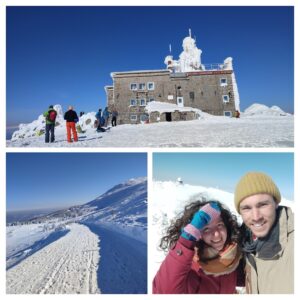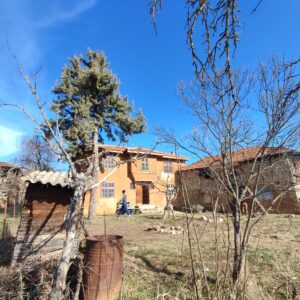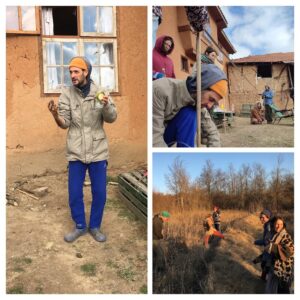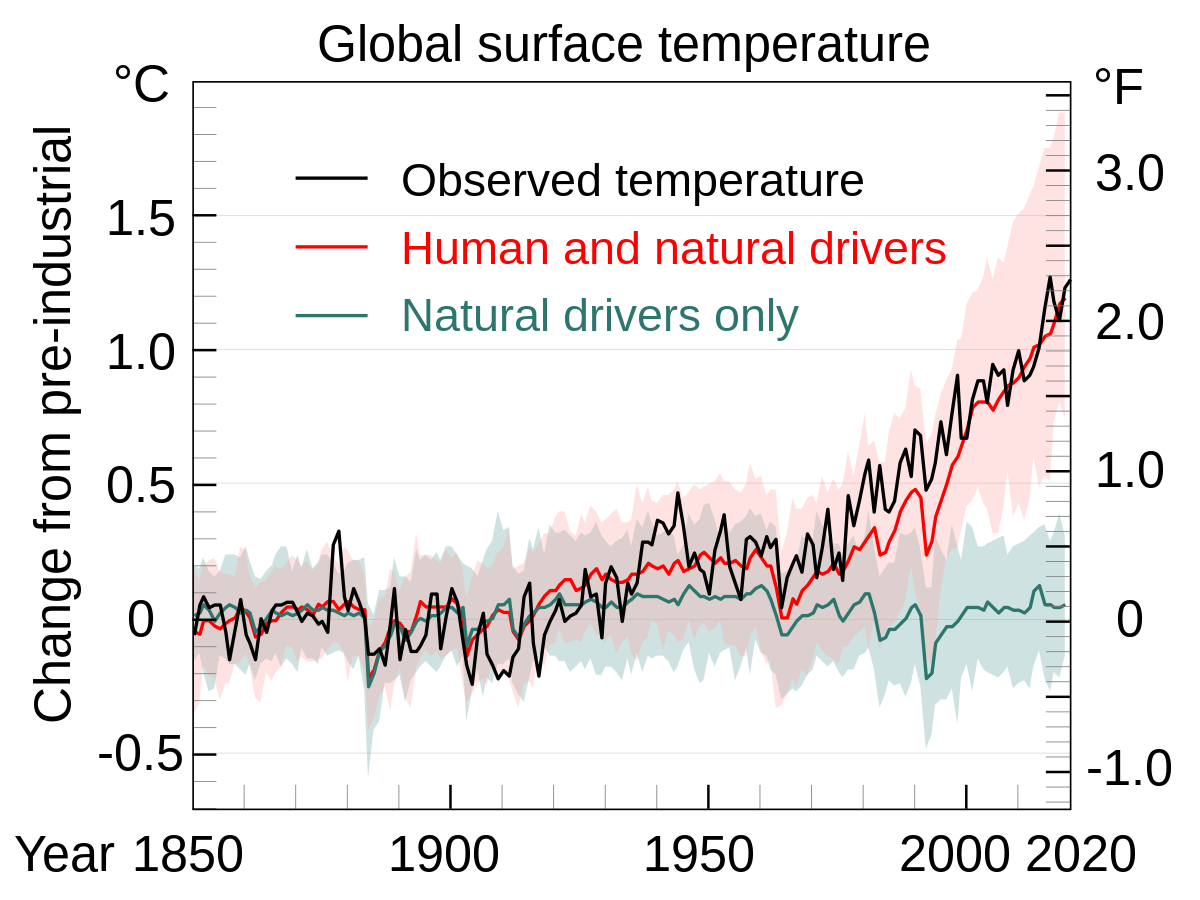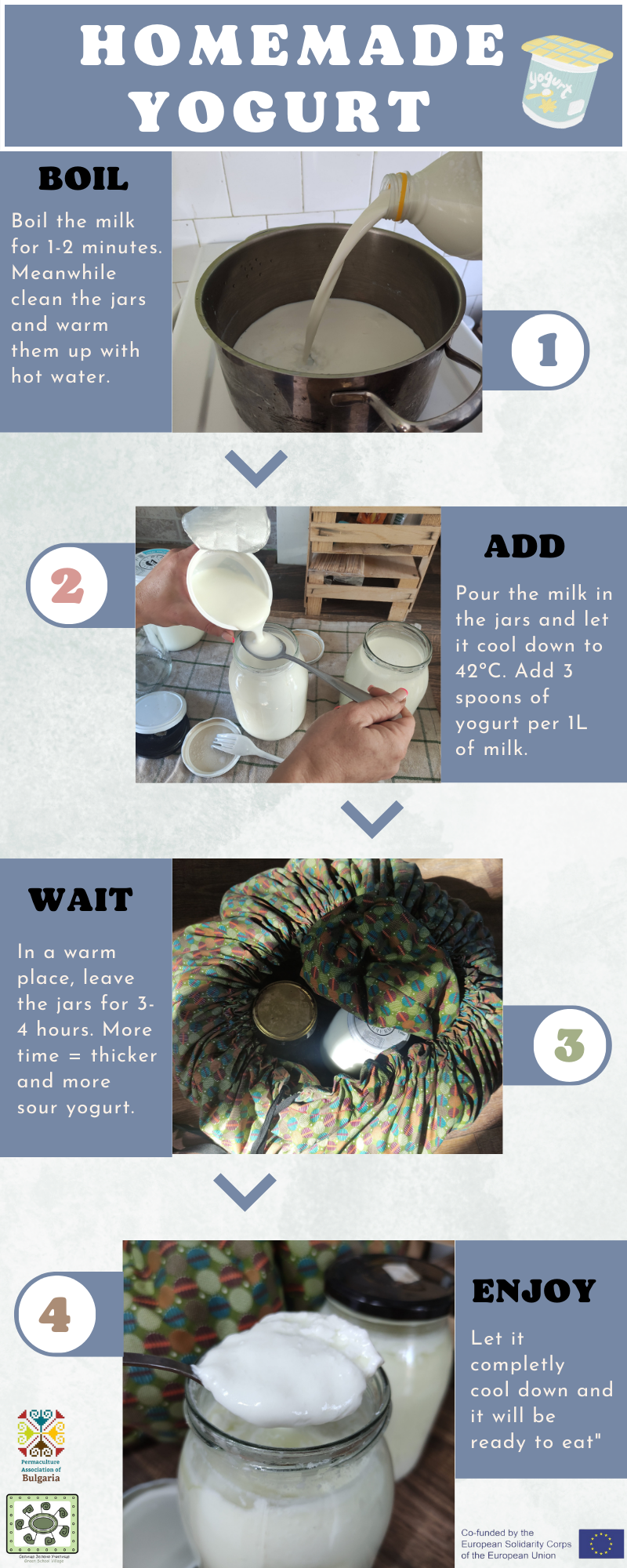Peter and Anastasja:
Hello fellow permaculture people,
This is our first blog post! We are new to this task, but we are happy to share some entertaining stories and useful information with you here.
As you already saw in our intro video, during our first days in Bulgaria we visited the Black Peak (Черни връх) on Vitosha Mountain, where we had our first taste of delicious Oyster Mushroom Shkembe soup and Leshta Chorba (Lentil soup). It was a really sunny day and we had a wonderful view over the snowy mountains.
UP: Cherni Vrah (Black Peak) hut (2290m). LEFT: The path to the Black Peak. RIGHT: Anastasja and Peter blinded by the Sun (photo credit: Peter Spornberger).
Besides this we explored Sofia, and joined the Sofia Free Tour which we really recommend to anyone new to the city, as it is both informative and fun.
On our third day we already left Sofia for Star Istevnik, a (very) small town in Northern Macedonia, where we participated in the first part of a 100-hour Integral Permaculture Design Course or “Practice-Enhanced Permaculture Design Course focusing on Environmental Restoration, Conscious Homesteading, Social Unity and Personal Growth”, organized by Green Association (http://www.greenassn.com/) and Natural Perspective (https://www.facebook.com/naturalperspective), and led in this first part by Filip Kirilov (https://vegetarium.info/), from the Permaculture Association of Bulgaria’s teacher’s pool. The course is a combination of a traditional PDC with an introduction to the so-called Integral Approach. The Integral Approach, as its name suggests, follows the principle of “AND instead of OR”, integrating the whole of the individual, social, and natural realm. Luckily, the European Solidarity Corps co-funded this project, so we and the other students could participate for free, in what would otherwise be an expensive course.
We were hosted by the lovely and kind Borce and Simona (Natural Perspective), who renovated the house we stayed in with a lot of effort and natural local materials, like clay and wood. Now, this 150 years old house is the perfect place to embrace a community in its cozy rooms.
House in Star Istevnik, home of Natural Perspective (photo credit: Peter Spornberger).
Following the Integral Approach, we had a daily regimen which should adapt our bodies and energy levels to the solar cycles, and through a specific nutrition, get the most out of our food to produce more serotonin and energy. Therefore, our days started before sunrise, at 6 AM, with our personal hygiene and drinking a few cups of hot water (to cleanse our body). Then we had one and a half hours of different physical exercises (Kundalini Yoga, the five Tibetans, Paneurythmic dancing, intuitive dancing…), breathing, and meditation, followed by a well-deserved porridge with a mountain of local fruits. A few of us, in the meantime, always took care of preparing breakfast, lunch, and dinner in advance. Like this, our teacher Filip and his partner Barbara showed us the Integral Approach to nutrition, and some basics of eco-housholding. We were inspired by this routine, and hope to keep up some of these healthy habits. We especially liked the morning practices, as they really help to wake up and feel energized (even if you just do a few of them to move your joints). We managed to keep up some of the other habits: for example, we are still eating porridge and fruits for breakfast, and we try to not look at our screens for too long before going to bed, also dimming the lights in our room, to have better sleep.
On our first day in the morning we planned everyone’s tasks for the week (cleaning, cooking, making fire…), an important part of community living, and had our first of many sharing circles.
The rest of our days consisted of lots of information about different topics, such as:
- Zones
- Sectors
- Slopes
- Mapping
- Client interview
- Google Earth Analysis
- Contour lines, key-lines, and key-points
- Water retention landscapes
- Different landforms and their purpose
And much more… As well as some basic principles of the Integral Approach:
- Nutrition
- Eco-housholding
- Some tools for teamwork and problem-solving (e.g. the four quadrants of Steven Covey)
LEFT: Filip throwing mud on the ground to test the soil composition (photo credit: Anastasja Giacomuzzi). UP RIGHT: Filip demonstrating how to use a waterlevel (photo credit: Peter Spornberger). DOWN RIGHT: People having fun while finding a contour line (photo credit: Peter Spornberger).
No worries, we will tell you more about all of this as we put what we’ve learned into practice 😉 .
During the lunch breaks we had time to walk around and explore the nature around Star Istevnik, seeing more and more patterns in the landscape as the week went on. At the same time we were stunned by the many facets of this town of 20 inhabitants; the many abandoned houses, the extremely friendly locals, the cows and other animals being pastured all around. We really hope that Borce and Simona’s projects come to fruition, and that it may contribute to filling those empty houses again.
In the evenings we had time to relax, share, and get to know each other. We watched some inspiring movies (e.g. Biggest Little Farm: Home | NEON biggestlittlefarmmovie.com), and enjoyed the coziness of the fireplace.
We are looking forward to continuing the second part of the course in Staro Stefanavo soon and to see everyone again!
До скоро,
Peter and Anastasja
François:
Dear readers,
As promised last week, I will today talk about permaculture in the context of climate change.
According to the United Nation’s website, “climate change refers to long-term shifts in temperatures and weather patterns. […] Since the 1800s, human activities have been the main driver of climate change, primarily due to burning fossil fuels like coal, oil and gas“. Thus, climate change is a modification of the general characteristics of the climate at a global scale. It is often referred as “global warming“, as it makes the Earth’s average temperature increase. However, this term should be used with caution, since this increase is not spread evenly in space and time, and can cause both extreme cold and heat waves. Climate change will especially bring a lot of uncertainty and extremities in our climates.
I’d like to remind you that, although science is always subject to debate, not every scientific theory is equivalent. The fact that climate change exists and is primarily caused by human activity is a scientific consensus, making it one of the strongest theories of all modern science -at the same level than evolution or special relativity. As such, it is more than prudent to say that climate change is not open to debate.
Evolution of the global surface temperature, 1850-2020 (photo credit: Efbrazil)
Climate change is of course a huge challenge for all humanhood and has an infinite number of consequences in all areas of human’s activity. But we will focus here on permaculture, which will already be big work 🙂 To do so, we will -quickly- try to cover the two issues that are to be dealt with: adaptation and mitigation.
Adaptation refers to the practices that need to be implemented to deal with the consequences of climate change. As we’ve discussed last time, climate has a lot to do with the way we grow plants. We’ve seen that the first step when studying the local climate is to inquire about extremes. We also know that climate change will increase the number of extreme events, and decrease weather’s predictability. To deal with those problems, the main solution is to value diversity! Growing plants with a variety of characteristics will allow your garden to survive a broad range a climatic events. In general, temperatures will increase, and thus you might have to grow more tropical varieties, and plants providing shade. However, you should check the local previsions, for example given by the IPCC reports or ONGs before designing.
Mitigation, on the other hand, cover all the techniques that will tackle the causes of climate change. We know that agriculture is one of the biggest emitters of greenhouse gases (GHG). As such, every technique that will either decrease the amount of GHG emitted or even store already-emitted GHG is useful. The latter is named carbon farming, and include practices such as no-tilling, cover crops or silvopasture -the fact of raising livestock in an food forest. For the first one, zoning will allow us to tend to energy efficiency.
To finish with, I’d like to come back to the topic of social permaculture, a topic that I already covered in my blogpost of week 34. Many thinkers, indeed, have stressed the need to incorporate economical, political, social and philosophical -on other terms, human- aspects to the tackling of the environmental crisis. As permaculturers, we are not aiming to design a garden that is resilient to climate change, but also to create a community that will also be able to do so. Since it’s a particular system that led to the destruction of the biosphere, only another system can repair it, and deal with its consequences. Climate change challenges us on an organizational level, for it needs us to think about non-human voices, environmental justice and long-term planning. In that context, it is highly beneficial to build strong and democratic communities, and to try new ways to make decisions. I won’t dive deeper into that topic, but I strongly invite you to do so, it’s fascinating!
I hope you found this post useful! I am aware that I covered many things, and only on their very surfaces. I will try to make some more focused posts in the future 😉
May your compost be the darkest possible,
François
Paula:
Hello dear readers!
This week, on our way to Panega Ecopath in Lukovit, we visited a buffalo farm. They had fresh milk so we decided to buy some! As I really like making fermented food and I had never done it before… we decided to make homemade yogurt and it worked! Therefore, I am going to share with you an easy and succesful recipe you can try at home.


